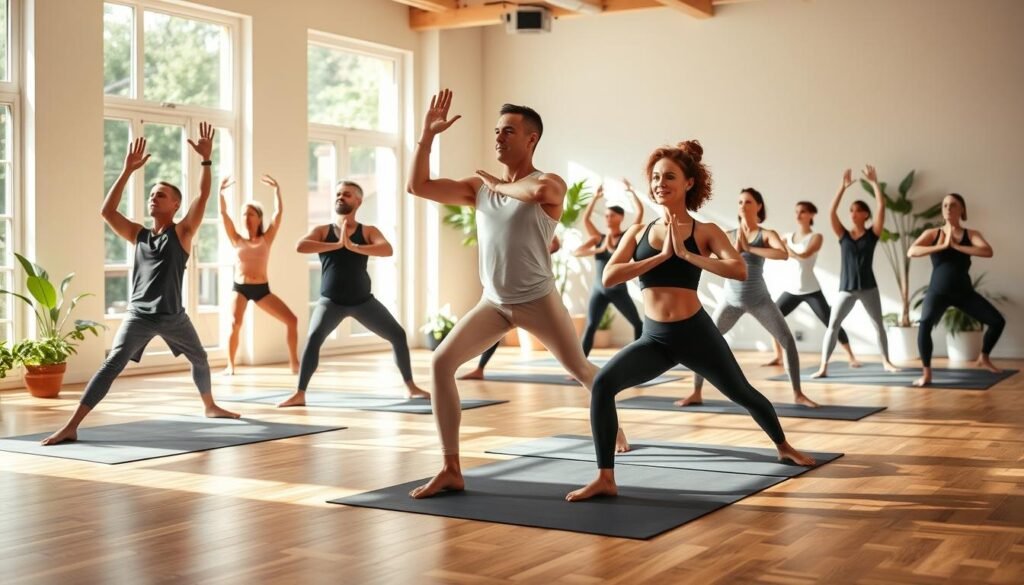Building strength and flexibility doesn’t need hours at the gym. Studies show short, focused workouts can change your health. The American College of Sports Medicine says do at least two 20-minute strength workouts a week to see changes.
Squats, planks, and yoga poses make muscles stronger and joints more mobile. This helps with better posture and prevents injuries. These exercises also help your mind: a 2024 study in Psychiatry Research found they lower depression and anxiety in older adults. In 2019, Sports Medicine Open showed they boost confidence in young people.
Getting fit starts with making smart choices. Mix strength exercises like deadlifts or lunges with stretches to fight muscle and bone loss as we age. Push-ups work many muscles, while planks strengthen your core and posture.
Doing squats right is key to safely building leg strength. These routines can also cut down on chronic pain and make daily tasks easier.
Key Takeaways
- Perform strength exercises 2+ times weekly for 15–20 minutes per session.
- Incorporate 150 minutes of moderate aerobic activity or 75 minutes of vigorous exercise weekly.
- Resistance training improves mental health, reducing anxiety and boosting self-esteem.
- Exercises like squats and planks build strength while enhancing flexibility and posture.
- Pair these routines with 2–3 weekly stretching sessions to improve mobility and injury prevention.
Introduction to Strength and Flexibility
Strength and flexibility are key to good health. Strength exercises help build muscle control and endurance. Flexibility routines improve joint mobility. Together, they prevent imbalances and support daily activities.
Modern lifestyles often ignore one or the other, leading to stiffness or weakness. Science proves that combining both improves posture, reduces injury risk, and boosts athletic performance.
Importance of a Balanced Fitness Routine
A balanced workout routines ensures muscles and joints work well together. For example, strength without flexibility limits movement. Flexibility alone weakens muscle support.
Research shows many benefits:
- Reduces fall risk in older adults by 40% through improved balance
- Enhances bone density, cutting fracture risk by 25%
- Boosts metabolic rate by 7-8% aiding weight management
Even 30 days of twice-weekly exercise routines show big improvements. For example, cancer patients report 30% less fatigue and better mobility through targeted strength work. Effective plans include controlled movements like squats and planks, paired with stretches for full-body readiness.
Start with simple routines: 2-3 weekly sessions mixing strength (e.g., squats, lunges) with dynamic stretches. Track progress by gradually increasing repetitions or resistance. This approach ensures sustainable progress without overexertion.
Exercise 1: Squats for Strength
Squats are key in strength training. They help build muscle in the legs, core, and glutes. This exercise works many muscles at once, making it great for staying fit and preventing injuries.
Variations of Squats
There are many squat types to fit your level and goals:
| Type | Benefits | Best For |
|---|---|---|
| Bodyweight Squats | Improves mobility and form | Beginners |
| Goblet Squats | Enhances core engagement | Intermediate lifters |
| Back Squats | Builds maximal leg strength | Advanced trainers |
Proper Squat Technique
- Feet shoulder-width apart, toes slightly outward.
- Push hips back, lowering until thighs are parallel to the floor.
- Keep chest up and knees aligned over ankles.
- Engage the core to stabilize the spine.
“Regular squats can reduce fall risk by 40% in older adults, per the CDC.”
A 2018 study showed back squats work the core 20% more than planks. For seniors, bodyweight squats boost mobility, helping with everyday tasks like getting up from a chair. Do squats 2-3 times a week, as the American Council on Exercise suggests, to see results in 8-12 weeks.
Exercise 2: Lunges for Lower Body Flexibility
Lunges are flexibility exercises that work on strength and movement. They target the glutes, quads, and hamstrings. They also help with balance.
These exercises prepare your body for everyday tasks like climbing stairs or bending. Doing them regularly can also boost your metabolism and lower injury risks.
Types of Lunges
- Stationary Lunges: Build a foundation by holding each position, focusing on form.
- Walking Lunges: Add motion to challenge core stability and increase calorie burn.
- Reverse Lunges: Reduce knee strain while emphasizing glute activation.
- Lateral Lunges: Stretch the inner thighs and outer hips for enhancing flexibility in sideward movements.
- Curtsy Lunges: Mimic stepping backward with one foot, engaging the glutes and improving hip mobility.
Tips for Effective Lunges
Keep your front knee aligned over the ankle and avoid leaning forward. Start with bodyweight, then add dumbbells or kettlebells as you progress. Aim for 2–3 sets of 8–12 reps per variation.
For exercise routines, pair lunges with squats or planks for full-body results. Always warm up with dynamic stretches to prevent strains.
Focus on controlled movements—pausing at the bottom of each lunge strengthens stabilizer muscles. If you have knee issues, opt for reverse lunges or reduce depth. Consistency in practice builds muscle tone and improves posture over time.
Exercise 3: Push-ups for Upper Body Strength
Push-ups are key in strength training, working the chest, shoulders, and core. They’re great for everyone, helping to build increasing muscle strength and improve core stability. A good warm-up (8–12 minutes) gets your muscles ready for the best workout.
Peloton’s Upper Body program adds push-up variations to weekly workout routines. This boosts functional strength and helps prevent injuries.

Focus on controlled movements to maximize muscle engagement while maintaining proper shoulder blade and spinal alignment.
Modifications for Beginners
Start with these easy variations for beginners:
- Incline push-ups: Hands elevated on a bench or step to reduce difficulty.
- Knee push-ups: Lower knees to the ground for support, maintaining a flat back.
- Wall push-ups: Performed against a wall for reduced load.
Progressing from Standard to Advanced Push-ups
Move up slowly to avoid injury and get the most out of your workout:
- Standard push-ups: Master form before progressing.
- Decline push-ups: Elevate feet to target upper chest and boost core engagement.
- Diamond push-ups: Hands close together to emphasize triceps.
- Plyometric push-ups: Add explosive jumps for power development.
Avoid mistakes like sagging hips or flared elbows. Keep shoulders aligned and engage the core. Regular practice helps build increasing muscle strength. Mix push-ups with dynamic stretches to improve mobility and prevent injury.
Exercise 4: Planks for Core Stability
Planks are a key part of strength training that helps build core strength without needing any equipment. By keeping your body straight, planks work deep core muscles. This is important for improving physical fitness and lowering injury risk.
Studies show planks can also improve posture, lessen back pain, and enhance daily movement skills.
“Regular planking improves postural stability, as shown in a study from Isokinetics and Exercise Science.”
Plank Variations for Every Skill Level
Everyone, from beginners to advanced athletes, can find a plank variation that suits their needs. Here are some main variations:
| Variation | Focus | Difficulty |
|---|---|---|
| Forearm Plank | Full core engagement | Beginner |
| Side Plank | Oblique strength | Intermediate |
| Plank Pull-Through | Dynamic core control | Advanced |
Mistakes to Avoid
- Sagging hips: Keep hips level with shoulders and heels.
- Elevated shoulders: Relax shoulder blades and avoid shrugging.
- Poor breathing: Inhale through the nose, exhale through the mouth while holding.
The American College of Sports Medicine says proper plank form helps avoid lower back strain. Start with 10-30 second holds and increase as you get stronger. Mix planks with other exercise routines like squats and lunges for a balanced workout. Aim to do planks 2-3 times a week for best results.
Exercise 5: Yoga Poses for Flexibility
Add yoga to your fitness plan to mix flexibility exercises with strength training. These poses boost joint movement and strengthen your core. They’re perfect for any . Start with basic poses and increase hold times as you get better.

Key Poses to Incorporate
Focus on these poses to work on major muscle groups:
- Downward-Facing Dog: Stretches hamstrings and calves, and strengthens arms and shoulders. Hold for 30-60 seconds.
- Warrior II: Opens hips and chest, building leg and core strength. Hold for 30 seconds on each side.
- Cobra Pose: Strengthens lower back and opens chest. Hold for 15-30 seconds.
- Pigeon Pose: Relieves hip tension and improves in glutes and hips. Hold for 1-2 minutes.
Benefits of Yoga for Strength
“Yoga’s isometric holds engage muscles similarly to resistance training, enhancing functional strength.” – Journal of Bodywork & Movement Therapies
Studies show yoga boosts blood flow to muscles, reducing stiffness and aiding recovery. The isometric holds in poses like Plank or Chair strengthen tissues without heavy weights. A 2022 study found yoga increased range of motion by 25% after 8 weeks.
Pairing yoga with weight training improves overall performance, as seen in a 2023 study. For best results, do 10-15 minutes of yoga daily with your workouts.
Yoga’s breath-synchronized movements also sharpen mental focus. This aligns with the American Osteopathic Association’s findings on mindful practice reducing chronic pain. Start with 3-5 repetitions per pose, increasing as your flexibility grows.
Exercise 6: Deadlifts for Full-Body Strength
Deadlifts are key in strength training, helping to build increasing muscle strength in many muscles. This exercise strengthens the back of your body, including your glutes, hamstrings, and lower back. It also improves your posture and helps with everyday lifting tasks.
Adding deadlifts to your fitness regimen can make your bones stronger and lower the chance of getting hurt. This is because doing them correctly helps your body stay in the right position.
Getting good at deadlifts means paying close attention to how you do them. Start with an empty bar or light weights to get the hang of it. Here are the main steps:
- Stand with your feet under the bar, hips above your ankles, and a straight spine.
- Use your core and push through the ground to lift, keeping the bar near your legs.
- At the top, squeeze your glutes and stand up straight.
Correct Deadlift Form
Here’s how to do it right:
- Setup: Bend at your hips, not your back. Keep your shoulders over the bar.
- Breathing: Breathe in before lifting, hold your breath while lifting, and breathe out at the top.
- Progression: Start with 3-4 sets of 5-8 reps. This is a good amount for building strength.
Common Pitfalls to Avoid
| Pitfall | Correction |
|---|---|
| Rounded back | Maintain a natural arch in the lower back |
| Overloading weight too soon | Master form with light weights first |
| Hyperextending knees/hips | Finish each rep with controlled lockout, not a thrust |
Try different deadlift styles like Romanian or sumo to fit your body and goals. Mix deadlifts with squats and planks for a well-rounded strength training routine. Always warm up before lifting to prevent injuries. Focus on doing the exercise correctly, even if it’s with lighter weights, to get the most benefits safely.
Exercise 7: Stretching Routines for Flexibility
Stretching routines are essential for enhancing flexibility and boosting physical fitness. Dynamic and static stretches have different roles in workouts. Knowing the difference helps make stretching safer and more effective.
Dynamic vs. Static Stretching
Dynamic stretching involves controlled movements to get muscles ready for action. Static stretching, on the other hand, holds positions to stretch muscles longer. Let’s look at how they compare:
| Type | Best Time | Benefits | Examples |
|---|---|---|---|
| Dynamic Stretching | Pre-workout warm-ups | Increases blood flow, primes joints | Leg swings, arm circles |
| Static Stretching | Post-workout or dedicated sessions | Improves long-term ROM, reduces stiffness | Hamstring hold, calf stretches |
A 2013 study in the Scandinavian Journal of Medicine & Science in Sports showed that static stretching before workouts can lower muscle performance. However, dynamic stretching, as found in a 2011 European Journal of Applied Physiology study, can improve sprinters’ performance. Mixing both types can enhance range of motion and prevent injuries.
Best Practices for Stretching
- Warm muscles first—stretch cold muscles risks injury
- Hold static stretches 30-60 seconds for each major muscle group
- Breathe deeply to enhance relaxation and depth
- Progress gradually—avoid pushing into pain
Regular stretching boosts mobility for everyday activities like bending or climbing stairs. Combining stretching with strength training can make workouts more efficient. For office workers, focusing on hip and back stretches during breaks can help counteract the effects of sitting.
Exercise 8: Burpees for Strength and Cardio
Burpees are a mix of strength training and cardio in one move. They raise your heart rate and work your legs, core, and arms. A 155-pound person burns 12.5 calories per minute, making them a great choice for any workout routines.
Breakdown of the Burpee
- Start in a squat with hands on the floor.
- Kick legs back into a plank position.
- Do a push-up, then return legs to squat stance.
- Leap upward from the squat position.
Proper form is key to staying safe. Make sure to control your movements in each step to engage your muscles fully.
Tips for Adding Burpees to Your Routine
- Beginners can skip the jump or push-up phase.
- Increase difficulty with weighted vests or adding a tuck jump.
- Pair with high knees, mountain climbers, and crunches in fitness regimen HIIT circuits.
Start with 8–10 reps, then increase as you get stronger. A 20-minute burpee session can burn 250 calories for a 155-pound person. Adding iFIT’s monthly HIIT updates keeps your workouts exciting.
Studies show burpees boost muscular endurance and balance. To improving physical fitness, do 2–3 burpee sets a week. Keep track of your progress and adjust the intensity slowly. Always focus on proper form to avoid injuries.
Conclusion: Making These Exercises Work for You
Turn the 10 Powerful Exercises into a fitness plan that fits your goals. You can focus on building muscle, improving flexibility, or boosting overall health. Mix strength exercises like squats and planks with yoga poses for flexibility.
Creating a Balanced Workout Plan
Start with a basic fitness plan that includes these exercises. For example, do squats and lunges for your legs, then stretch with yoga. Aim for 8–12 reps per set and increase the weight as you get stronger. Remember to rest to let your muscles heal.
Try mixing push-ups, deadlifts, and stretches to work all your muscles. This will help you stay balanced and effective in your workouts.
Staying Motivated and Consistent
Stay on track by setting clear goals. Use a journal or app to track your progress. Exercise with a friend or join a class like Tai Chi for seniors to keep you motivated.
Begin with a 20-minute routine: 10 squats, 30-second planks, and 5 minutes of stretching. As you get stronger, increase the intensity. Choose exercises you like to keep up with them long-term.



